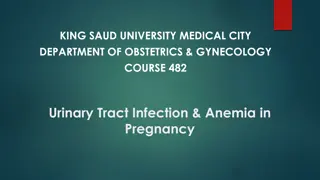Understanding Ectopic Pregnancy: Causes, Risk Factors, and Complications
Ectopic pregnancy occurs when a fertilized egg implants outside the uterus, most commonly in the fallopian tubes. This condition, if left untreated, can lead to serious complications, including maternal mortality. Risk factors such as previous ectopic pregnancy, tubal surgery, and smoking increase the likelihood of ectopic pregnancies. Early diagnosis is crucial to prevent severe outcomes associated with this condition.
Download Presentation

Please find below an Image/Link to download the presentation.
The content on the website is provided AS IS for your information and personal use only. It may not be sold, licensed, or shared on other websites without obtaining consent from the author. Download presentation by click this link. If you encounter any issues during the download, it is possible that the publisher has removed the file from their server.
E N D
Presentation Transcript
Introduction: The blastocyst normally implants in the endometrial lining of the uterine cavity. Implantation anywhere else is considered an ectopic pregnancy. It is derived from the Greek ektopos out of place . Incidence:- According to the American College of Obstetricians and Gynecologists (2008), 2 % of all first-trimester pregnancies in the United States are ectopic, and these account for 6 % of all pregnancy-related deaths.
Classification Nearly 95 % of ectopic pregnancies are implanted in the various segments of the fallopian tubes .Of these, most are ampullary implantations. The remaining 5 % implant in the ovary, peritoneal cavity, or within the cervix.
Risk Factors 1-previous ectopic pregnancy 3-13% 2-Tubal corrective surgery 4% 3-Tubal sterilization 9% 4-Intrauterine device 1-4% 5-Documented tubal pathology 3.8 21% 6-Infertility 2.5 3% 7-Assisted reproductive technolog y 2 8% 8-Previous genital infection 2 4 % Chlamydia 2% Salpingitis 1.5 6.2%
9-Smoking 1.74% 10-Multiple sexual partners 1.6 3.5% 11-Prior cesarean delivery 1 2.1% 12-Maternal age (peak 25 to 34 years).
Mortality rate: This condition still causes about 10% of maternal deaths in the USA . Pathophysiology: In theory, any mechanical or functional factors that prevent or interfere with the passage of the fertilized egg to the uterine cavity may be etiological factor for an ectopic pregnancy. In general the main cause is a low grade infection- chronic PID. In an ectopic pregnancy, the uterine endometrium usually responds to the hormonal changes of pregnancy & undergoes focal decidual
Natural history of untreated tubal pregnancy: 1.Tubal rupture. 2.Pregnancy resorption. 3.Tubal abortion into the peritoneal cavity. Diagnosis: Symptoms of ectopic pregnancy tend to have a poor positive predictive value to help discriminate between intra & extra uterine pregnancy. They may present as acute/ subacute or silent presentation.
Clinical presentation: A-Acute presentation (tubal rupture): 1-Acute abdominal pain referred to the shoulder tip. 2-Cardiovascular collapse. 3-Uterus slightly enlarged & there is a tender mass to one side. 4-Positive cervical excitation. .a
b. Subacute presentation: Give rise to diagnostic confusion. 1.Abdominal pain which can be localized to one iliac fossa. 2.Delayed menstruation. 3.Episodes of vaginal bleeding. 4.There may be referred pain to shoulder. 5.Abdominal & pelvic examination reveal sign of peritoneal irritation less marked than in an acute situation. c. Asymptomatic (silent presentation).
Signs: often have no specific signs: 1.Rapid heart rate, low BP may be noticed. 2.peritonism (due to intra abdominal blood if ruptured). 3.Gynecological examination: speculum or bimanual examination must be performed in an environment where facilities for resuscitation are available because may provoke tubal rupture. uterus usually normal size. cervical excitation & tenderness occasionally. adnexial tenderness. adnexial mass.
Investigation: I.Ultrasound: Transvaginal U/S : gestational sac of an intra uterine pregnancy should be detectable when serum B-hCG level exeeds 1000IU/L. The presence or absence of an intra uterine gestational sac is the principle point of distinction between intra uterine and tubal pregnancy. Morphology of ectopic pregnancy can be classified by U/S into 5 categories: 1.Gestational sac with a live embryo. 2.Sac with an embryo but no heart rate. 3.Sac containing yolk sac. 4.Empty gestational sac. 5.Solid tubal swelling
The presence of fluid in the pouch of Douglas is a non specific sign of ectopic pregnancy. In 10 - 20% of ectopic pregnancy a pseudo gestational sac is seen as a small, central located endometrial fluid collection surrounded by a single echogenic rim of endometrial tissue undergoing decidual reaction.
II. Biochemical measurements: Serum hCG: Healthy normally developing pregnancies generally can be detected by a normal rate of increase of maternal serum B-hCG levels. Normal pregnancies show doubling of hCG levels every 48 hours in the first few weeks of pregnancy & sub optimal rise is suspicious of an ectopic pregnancy i.e. a prolonged hCG doubling time is an indicator of an abnormal pregnancy.
2. Serum progesterone: Serum progesterone levels will respond quickly to any decrease in hCG production. Serum progsterone <20 nmol/L reflects fast decreasing hCG levels and can be used to diagnose spontaneous resolving pregnancies. Progesterone level >60 nmol/L indicate normal increase in hCG level, Those between 20 & 60 nmol/L are strongly associated with abnormal pregnancy
Culdocentesis This was used commonly in the past to identify hemoperitoneum . A 16-18 gauge needle is inserted through the posterior vaginal fornix into the cul-de-sac. If fluid present can be aspirated, however, failure to do so is regarded as only unsatisfactory entry into the cul-de-sac and does not exclude an ectopic pregnancy, either ruptured or unruptured .
Multimodality Diagnosis: Ectopic pregnancies are identified with the combined use of clinical findings along with serum analyte testing and transvaginal sonography. A number of algorithms have been proposed, but most include five key components: 1.Transvaginal sonography 2.Serum hCG level both the initial level and the pattern of subsequent rise or decline 3.Serum progesterone level 4.Uterine curettage 5.Laparoscopy and occasionally, laparotomy.
Management Surgical Management Laparoscopy is the preferred surgical treatment for ectopic pregnancy unless the woman is hemodynamically unstable. There have been only a few prospective studies in which laparotomy was compared with laparoscopic surgery
1-Each method was followed by a similar number of subsequent uterine pregnancies. 2-Laparoscopy resulted in shorter operative times, less blood loss, less analgesic requirements, and shorter hospital stays 3-Laparoscopic surgery was slightly but significantly less successful in resolving tubal pregnancy. 4-The costs for laparoscopy were significantly less, although some argue that costs are similar when cases converted to laparotomy are considered..
Tubal surgery is considered conservative when there is tubal salvage. Examples include salpingostomy, salpingotomy, and fimbrial expression of the ectopic pregnancy . Radical surgery is defined by salpingectomy .
Salpingostomy This procedure is used to remove a small pregnancy that is usually less than that is usually less than 2cm in length and located in the distal third linear incision is made with unipolar needle cautery on the antimesenteric border over the pregnancy. The products usually will extrude from the incision and can be carefully removed or flushed out using high-pressure irrigation that more thoroughly removes the trophoblastic tissue The incision is left unsutured
. Salpingotomy Seldom performed today, salpingotomy is essentially the same procedure as salpingostomy except that the incision is closed with delayed-absorbable suture. Salpingectomy Tubal resection may be used for both ruptured and unruptured ectopic pregnancies. When removing the oviduct, it is advisable to excise a wedge of the outer third (or less) of the interstitial portion of the tube. This so- called cornual resection is done in an effort to minimize the rare recurrence of pregnancy in the tubal stump.
Medical Management Methotrexate This folic acid antagonist is highly effective against rapidly proliferating trophoblast, and it has been used for more than 40 years to treat gestational trophoblastic disease .It is also used for early pregnancy termination Active intra-abdominal hemorrhage is a contraindication to chemotherapy. other absolute contraindications include intrauterine pregnancy; breast feeding; immunodeficiency, alcoholism; chronic hepatic, renal, or pulmonary disease; blood dyscrasias; and peptic ulcer disease.
Patient Selection The best candidate for medical therapy is the woman who is asymptomatic, motivated, and compliant. With medical therapy, some classical predictors of success include: 1.Initial serum hCG level. This is the single best prognostic indicator of successful treatment with single-dose methotrexate. The prognostic value of the other two predictors is likely directly related to their relationship with hCG concentrations 2.Ectopic pregnancy size. Although these data are less precise, many early trials used "large size" as an exclusion criterion. a 93% success rate with single-dose methotrexate when the ectopic mass was <3.5 cm, compared with success rates between 87 90 % when the mass was >3.5 cm. - 3.NoFetal cardiac activity .
Expectant Management In select cases, it is reasonable to observe very early tubal pregnancies that are associated with stable or falling serum hCG levels, restrict expectant management to women with these criteria: 1.Tubal ectopic pregnancies only 2.Decreasing serial hCG levels 1500 3.Diameter of the ectopic mass not >3.5 cm 4.No evidence of intra-abdominal bleeding or rupture by transvaginal sonography. expectant therapy is undertaken only in appropriately selected and counseled women .
Increasing Ectopic Pregnancy Rates A number of reasons at least partially explain the increased rate of ectopic pregnancies in the United States and many European countries. Some of these include: 1-Increasing prevalence of sexually transmitted infections, especially those caused by Chlamydia trachomatis 2-Identification through earlier diagnosis of some ectopic pregnancies otherwise destined to resorb spontaneously 3-Popularity of contraception that predisposes pregnancy failures to be ectopic 4-Tubal sterilization techniques that with contraceptive failure increase the likelihood of ectopic pregnancy 5-Assisted reproductive technology 6-Tubal surgery, including salpingotomy for tubal pregnancy and tuboplasty for infertility
Differential diagnosis of ectopic pregnancy: Gynecologic problems: Threatened or incomplete abortion. Ruptured corpus luteum cyst. Acute PID. Adnexal torsion. Degenerating leiomyoma (especially in pregnancy). Non- gynecologic problems: Acute appendicitis. Pyelonephritis. Pancreatitis.























